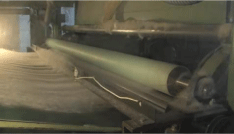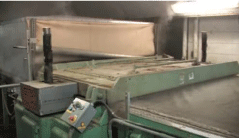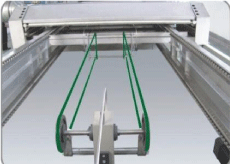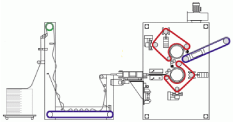
Review Article
Adv Res Text Eng. 2021; 6(1): 1060.
Compactor Felt: Over View, Different Brand Analysis and Comparison
Alam SMM¹*, Prithila Kamal¹ and Shariful Islam²
¹Department of Textile Machinery Design and Maintenance, Bangladesh University of Textiles, Bangladesh
²Department of Textile Engineering, City University, Bangladesh
*Corresponding author: Shaikh Md. Mominul Alam, Department of Textile Machinery Design and Maintenance, Faculty of Science and Engineering, Bangladesh University of Textiles, Tegjaon, Dhaka, Bangladesh
Received: February 01, 2021; Accepted: March 03, 2021; Published: March 10, 2021
Abstract
The aim of this paper is to discuss about compactor felt, it’s over view, discuss about different brand analysis and comparison. In today’s world textile industry is occupied as a large sector, where fabric finishing and maintain fabric quality is a great challenge. In the finishing section, a compactor machine performs the final task of compaction, heat setting, weight in Gram per Square Meter (GSM), dimensional stability and other property control. To accomplish these important tasks mainly compactor felt is responsible, so it is very important to get a crystal clear idea on compactor felt. For this purpose, this review paper is so helpful. After reading this paper if anyone wants, they can also research on felt properties in depth and work on it to improve felt quality in future, as this paper would provide a basic concept.
Keywords: Albany international; Bowoo; Compactor felt; Dolfuss & muller; Needled felt; Nomex; Polyester
Introduction
There is a great importance of this paper in the field of textile industries since, compactor felt plays a significant role to run the machines. This is an overview of compactor felt, which plays a very important role in the field of fabric finishing process in textile industries. After the entire dying process, the knit fabrics are sent to the finishing section where compactor machine occupies in the last. A compactor machine performs some important functions such as controlling fabric’s dimensional stability, shrinkage control, weight in Gram per Square Meter (GSM) control, heat setting etc [1]. The component which has a vital role in this total compaction process is the felt. A compactor usually has two felt unit .The endless felt is wrapped around a heated cylinder along with the support of 3 to 4 idle rollers. Among the factors that affect the compaction process, felt type and quality is a major one [2]. Therefore, it is very important for anyone who is related to textile sector to know about each and every detail regarding a compactor felt. This article will give a detail over view about the felt types, its manufacturing process, raw materials, lifetime, and impacts on fabric and world best felt manufacturers [3]. After going through this writing, it will be easier to determine the best quality felt and compare between different felt types. If an individual doesn’t learn about the details of raw materials used in an endless felt, their properties and how they are connected to the finished knit fabric quality, will not be able to work further on knit fabric quality improvement. From this perspective, it’s going to be a very beneficial one.
Overview
Felt
Felt is a textile material, which can be endless or open, produced by matting fibers, condensing and pressing them together. Wool fiber was initially used for producing felt, but now synthetic fibers like polyester, high performance fibers like polyamide are being used for better-felt performance. Felt has an outstanding property of holding and distributing heat evenly [4].
Compactor felt
Compactor felt is an endless needled felt, which is consist of polyamide, polyester and wool. It has the ability of withstand a high amount of heat during the compaction process and a very smooth surface. In the compaction unit, the knit fabric comes in contact with the felt surface [5].
Main elements of a compacting felt
Felt was initially produced from natural wool. Then it gradually shifted to any synthetic fibers like polyester or blends and then to high performance fibers. But when we are about to make an endless felt belt for a compacting machine we must consider the properties that is relevant to the compacting process.
Nomex is used on the surface layer since it has some outstanding properties like high heat resistence, tearing strength, non-flammable and so on. Polyester and wool is used on the bottom layer. So mostly compactor felt is three ply felt, if needed it can be moderated. Now as we know Kevlar and Nomex both belong to aramid fiber group, but we use Nomex fiber for compactor felt instead of Kevlar. It’s because of the heat resistance property [6]. Generally, Kevlar shows heat resistance up to 480°C, where as Nomex shows up to 280°C and Polyester up to 180°C. In compactor machine, the temperature doesn’t go above 280°C. Therefore, a mixture of Nomex and Polyester ply is sufficient for compactor felt to withstand the heat generated in the compaction process. Hence, Kevlar felt is not required [7].
General characteristics of compactor felt
The compactors are to be manufactured from aramid /poly amid/wool. Aramid is used since the aramid surface can provide high temperature resistance up to 190°C long lifetime. A standard Specification is, working temperature-230°C (100% Nomex), thickness 18 to 22 mm, Inner circumference 2000 to 6000 mm, width <3200mm, weight-8000g/m² (20mm thick). Nomex can be used in the ratio of 100%, 50%, 30%. As Nomex percentage decreases, polyester ratio will increase and temperature resistance will decrease [8].
Felt Manufacturing Process
Felt can be made in different methods. Mostly two used methods are – pressed felt method needle punch method.
Pressed felt
This is the most common type and the oldest one. Initially basic wool felts were made in this process. In this method, fibers are compressed by using heat and moisture causing the fibers to interlock with each other. Heat, moisture, motion and pressure are the main factors here. Along with wool, other synthetic or blend of synthetic fibers can be used. Both wool and polyester ply can be processed following this method. This method is cheap than needle punching process but comparatively process thick web. Since we can produce our wool/polyester ply in this process and then use in final felt production, this is why this method has been described briefly as well [9].
• At first different grades of wool, bales arrive and they are mixed according to the category we want.
• Then the bales are sent for breaking, it kind of works like cotton bale breaker machine.
• There is a rotating comb that helps to card the fibers from the bale, align them into very fine layers, which are called batts. Batts are actually fluffy webs. (Figure 1) shows fluffy web formation.

Figure 1: Batt (fluffy web formation).
• The batts are layered over one another by a conveyor, further those web layers are pressed together to get a desired thickness.
• Then the layered batts are covered with a wetted canvas, steam is applied. This wetted canvas helps to prevent the steam from escaping. The steam is given so that the fibers open up their scale structure. It helps later to be entangled with each other.
• Then there is a oscillating plate in the machine, this plate presses the batts, keeps vibrating .Steam is also applied. So the combination of steam, pressure, plate movement and moisture helps the fibers to entangle with each other and form a felt. (Figure 2) shows Oscillating plate and steam apply.

Figure 2: Oscillating plate and steam apply.
• For some special use, the felt is processed further. Hot water is sprayed on felt and hardened to get even more compact better quality felt.
• Irregular edges of the felt are cut by a selvedge cutter. The felt is dried and pressed to ensure a uniform thickness.
• The final product is delivered in roll form. (Figure 3) shows final product (felt) in roll form.

Figure 3: Final product (felt) in roll form.
Needle felt
Needle punch method is most popular all around the world. The felts used in compacting zone are made in this method, because it produces more compact, solid web. The machine contains thousands of needles that continuously stab the fibers, grab and pull them to intermesh with each other [10]. Needle felt process has been described briefly:
• At first we will take bale of polyester / aramid fiber or any fiber we want. Then feed it in feeder conveyor belt.
• Then a rotating bed with thousands of protruding spikes takes the fiber from feeder conveyor and rotates along with the fiber. There is another spiked conveyor but it rotates in different direction. The spikes of opposite rotating direction grab and pull the fibers. As a result, the bale fibers get carded and individualized. (Figure 4-6) shows Conveyor with protruding spikes for carding process.

Figure 4: Conveyor with protruding spikes for carding process.

Figure 5: Albany compactor felt [12].

Figure 6: Bowoo felts types [24].
• Fibers are loosened up and here is a magnetic metal detector, it collects if there are any metals running with the fiber. (Figure 7) shows Conveyor with protruding spikes for carding process.

Figure 7: Endless felts for compacting machines and calendars [25].
• Now the fibers will enter into a series of pinned roller, they rotate in different direction so the fibers can be more aligned. This creates a uniform web of fluff.
• Then this fluffy web goes over a cross lapper, it is basically a system of conveyors that move back and forth to fold up the formed webs neatly.
• Then this layered webs travel between rollers, where the layers get squeezed to a thickness of little more than a centimeter.
• Thousands of needles repeatedly stab the compressed web to entangle the fibers.
• Each needle has 9 or more barbs that help in enmeshing the fibers in the web.
• It eventually transforms the compacted fluff into a felt. Then the formed felt is wound on to a roller and ready for further process.
Now 3 ply or more number of plies are subsequently entangled by needle punching. But now the longer needles are used. Continuous needle punching makes several plies a single sheet. The smoothness and better surface quality depends on the number of needle punch.
For endless felt the needle, punching is done in a special way at the edge. Hard treatment can be done or other treatments are executed as per the requirements.
Effect of Felt on Finished Fabric in a Compactor Machine
Felt is constructed in such a way that it can spread temperature uniformly. In a compactor machine, particularly in the compacting zone the heat is supposed to be spread uniformly all over the fabric surface in order to execute the compaction process more precisely. Nothing can be a better option than felt for this purpose. So the endless felt is installed around the heated cylinder and the fabric passes between them. The felt belt holds the heat and makes it to the maximum so that the fabric can get compacted well. Moreover, it can also protect the fabric from any possible spots caused by uneven distribution of heat.
Reason behind using aramid (Nomex)
As we know the main purpose of a compactor machine is to preshrink the fabric to give it a permanent stability to stop any further shrinkage during the washing process of a garment [11]. The aramid felt has that ability to facilitate this effect. Aramid felts can improve the fabric handle. If we at a glance see the compaction process again, we can see that in the compaction process the amount of shrinkage required is between 2% to 10%.This shrinkage is supposed to be given mechanically on both side of the fabric. For this purpose the machine uses two consecutive endless felt along with temperature (110-160°C/280-320°F) and steam pressure. For heat setting process it can be carried out under (180-200°C/350-400°F). So it’s very evident that the endless felt is always in contact with the heated cylinder and supposed to face a huge amount of heat every time the machine run. Under this circumstance aramid felt is a very good option to withstand high temperature, as its heat resistance property is good. Aramid fiber is a high performance fiber providing some outstanding properties that easily facilitate the compacting felt characteristics.
Renowned Felt Manufacturer’s World Wide
Among hundreds of manufacturers, the companies that deserve to be appreciated for their tremendous contribution in textile field for felt manufacturing are mainly Dolfus & muller, Albany international, Bowoo. World best compactor machines like Ferraro, Lafer, Santex etc use their felts.
Albany international
They use high quality materials and latest technology for serving their valued customers. Some of their esteemed customers are Ferraro, Lafer, Albrecth, Monti Antonio, Muzzi. They have different felt models with different structure and property. Figure 5 shows Albany compactor felt.
Knitted fabric compaction heat-setting felt:
• B-SAN/2-Weight is 6.5-8.5 g/m², thickness is 160-200 mm, Temperature is 180°C.
• B-SAN/3-Weight is 9g/m², thickness is 210mm, Structure is endless needled felt with woven base fabric.
Properties: B-SAN/2 and B-SAN/3 has same properties.
The felt has a very smooth surface. It shows a very excellent heat resistance to high temperature. This felt has even thickness, which is also important. It provides excellent compaction effect. It is long lasting and economical.
B-SAN XY5113-Weight is 6g/m², Thickness is 120-140 mm.
B-SAN XY5115-Weight is 6.7g/m², Thickness is 1160 mm.
B-SAN XY5120-Weight is 8.5g/m², Thickness is 180-200 mm.
B-SAN XY5122-Weight is 10g/m², Thickness is 200-220 mm.
Properties: B-SAN XYZ5113, B-SAN XYZ5115, B-SAN XYZ5120, B-SAN XYZ5122 all these models are Nomex-synthetic composed endless needled felt with base woven fabric [13]. They have same properties, such as even thickness, adequate heat resistance, Shows excellent compaction effect and Working economy.
Albany felt manufacturing technique: Albany international manufacture follows the needled felt “sandwich” technique. According to this process the felt structure is consist of-needled batt with base fabric [14]. This structure makes the felt structure even more strong, stable and resilient. They consider three factors, i.e. (application of felts, cost and machinery used) while choosing the felt materials, felt design and manufacturing parameters [15].
Woven base fabric: Albany international runs the whole needling process on a base fabric, which is previously woven (can be open or tubular). As a result, this woven base fabric provides a good mechanical strength to the final felt structure [16].
Material used: They needle different kinds of fibers like polyamide, polyester, recycled fibers, and high tech fibers like Nomex.
Needling machine: The needling machine has a needle board (5000-6000 needles per board) which is in downward orientation. The main principle is the needle board will move up and down so the needles can easily penetrate into the layer of fibers that is already pre-combed [17]. This mechanical action of needles actually helps the fibers to entangle with each other and also brings the fibers to the felt core (woven base) and link with it [18].
Finishing process: Albany international also follows the process of finishing obtaining desired thickness and surface smoothness [19]. In their finishing process they include Washing, Stress relieving, Heat setting, Buffing, Cutting to width.
Felt quality: Albany felt quality ensures the quality of the woven fabrics. With the best quality felt, it will provide the best possible stability, strength and resilience of the felt. For this particular reason every felt manufacturers have their own weave as well as the Albany international has the same [20].
Quality of needled fibers: The felt quality depends on which type of fibers are being needled. Usually for compactor felt Nomex fibers are needled which gives the best quality felt.
In recent technology along with the synthetic fibers, natural fibers like wool are also added. But in this case, the percentage of wool is an important factor [21]. If the ratio of wool is more than 30%, a large part of it breaks down by the needle strokes and the mechanical strength falls. Again to get better quality felt, the tuning of the needling machine with forward speed of layers and penetrates the depth of needles; all three has to be precisely maintained and undoubtedly it is a difficult task [22].
In the market where, most of the felts are needled straight away on the fabric, whereas Albany international uses pre-needled base fabric which gives better resilience [23]. This is why the cross section of Albany international felts show small layer of fibers between each base fabric.
Metal detection: While manufacturing dense and thick felts it is possible that the needles break into the felt. But Albany International always ensures safety and felt quality. So they have metal detectors in two different phases. After the presence of broken needle is ensured, the needles are removed manually.
BOWOO
Bowoo was established in 1988 and successfully manufacturing endless felt for textiles as well as other sectors since then. Some of their esteemed customers are Ferraro, Sperotto, Rimer, Santex, Lafer, Monforts, Bianco, Fong’s etc. (Figure 6) shows Bowoo felts.
Material: Bowoo manufactures felts using Nomex (meta aramid), polyester, and wool.
Working temperature: The working temperature is related with the percentage of raw material used.
NOMEX 100%: 230°C-Heat compacting machine.
Nomex 50% (surface) + Polyester 50%: 180oC-Heat compacting machine.
Nomex 30% (surface) + Polyester 70%: 150oC-Steam compacting machine.
Polyester 100%: 150°C-Steam compacting machine.
On customer demand, Bowoo also moderates the dimension of the felt. (Table 1) shows the details chart of different felt types.
Machines
Fiber composition
Thickness (in mm)
Maximum Working temperature
Weight (g/m2)
Ferraro, Lafer, Santex, Bianco, Fong’s
100% aramid contact surface. Content of aramid on the full felt thickness: 40%
21mm
230°C
450°F8495
Monforts, Old santex, Old sperotto, Old Ferraro
100% Aramid contact surface. Content of Aramid on the full felt thickness:40%
18mm
230°C
450°F7505
Old Santex, Old Monforts, Monti
100% aramid contact surface. Content of aramid on the full felt thickness: 40%
16mm
230°C
450°F6495
Old Ferraro
100% aramid contact surface. Content of aramid on the full felt thickness: 40%
14mm
230°C
450°F5505
Old Santex tubular
Wool-Polyamide-Polyester
13mm
160°C
320°F6495
Table 1: Details chart of different endless felt types (compacting machine).
Dolfus and muller
They provide very high quality felt in market. Their felt type, felt specification, working parameter, machine in which their felt is used are provided in the following (Table 1).
Dollfus & Muller presented its latest compacting felt for textiles finishing with major progresses on the market against the prevailing products. These felts are at present available from the last few decades in diverse conditions in Bangladesh.
The compactor is basically prepared with two steam compartments and two felts. Most of them are steam-heated but several are furnished with a thermo-oil tempering system to process the artificial fabrics. (Figure 7) shows endless felts for compacting machines and calendars.
Conclusions
Textile industry is a huge sector, where there are more things to know. This paper will facilitate people to have an elaborate idea on compactor felt. Due to insufficient knowledge about compactor felt many people face huge trouble to maintain the fabric quality and effective costing. This paper will help people in future to have a clear concept on felt specification and to choose the right type of felt for their compactor machine.
References
- Van Capelleveen G, Amrit C, Zijm H, Yazan DM and Abdi A. Toward building recommender systems for the circular economy: Exploring the perils of the European Waste Catalogue. Journal of environmental management. 2021; 277: 111430.
- Eglash R, Robert L, Bennett A, Robinson KP, Lachney M and Babbitt W. Automation for the artisanal economy: Enhancing the economic and environmental sustainability of crafting professions with human-machine collaboration. AI & SOCIETY. 2020; 35: 595-609.
- Bouckaert TV and Leroux RA. Bouckaert Industrial Textiles Inc. Absorbent non-woven felt material and method of making same. U.S. Patent. 2009; 7: 364.
- Brillowski F, Dammers H, Koch H, Müller K, Reinsch L and Greb C. Know- How Transfer and Production Support Systems to Cultivate the Internet of Production Within the Textile Industry. In International Conference on Intelligent Human Systems Integration. 2021: 309-315.
- Liu M, Glanc-Gostkiewicz M, Beeby S and Yang K. Fully Printed Wearable Electrode Textile for Electrotherapy Application. In Multidisciplinary Digital Publishing Institute Proceedings. 2021; 68: 12.
- Gloy YS. Assistance Systems in Textile Production. In Industry 4.0 in Textile Production. 2021: 195-262.
- Mikolajczyk Z, Szalek B and Pieklak K. Empirical Analysis of the Impact Strength of Textile Knitted Barrier Meshes. Autex Research Journal. 2020.
- Kaiser RF. Kera-Plast: Exploring the plasticization of keratin-based fibers through compression molded human hair in relation to textile design methods. 2020.
- Tandy T, Tirtaatmadja A and Widyani AI. Attraction of Interactive Display at the Main Exhibition Hall of Jakarta Textile Museum. In the 2nd Tarumanagara International Conference on the Applications of Social Sciences and Humanities (TICASH 2020). 2020: 216-224.
- Scortegagna B. Compacting machine for fabrics and corresponding compacting method. U.S. Patent. 2018.
- Nomex. A flame-resistant meta-aramid material. Manufactured by DuPont. 1960.
- Albany International. Albany Felt Company. Albany Engineered Composites and Machine Clothing. Albany County, New York, United States. 2008.
- Saggiomo M, Kemper M, Gloy YS and Gries T. Weaving machine as cyberphysical production system: Multi-objective self-optimization of the weaving process. In 2016 IEEE International Conference on Industrial Technology (ICIT). 2016: 2084-2089.
- Adanur S and Qi J. Property analysis of denim fabrics made on air-jet weaving machine part II: Effects of tension on fabric properties. Textile Research Journal. 2008; 78: 10-20.
- Lima M, Fangueiro R, Costa A, Rosiepen C and Rocha V. Multiweave–A prototype weaving machine for multiaxial technical fabrics. 2009.
- Zhen XIE and Zongnong CHEN. Control system of digital weaving machine based on ARM and μC/OS. Journal of Textile Research. 2008; 3: 105-109.
- Kim SJ, Jin YD and Jung GJ. Effects of Weaving Machine Characteristics on the Physical Properties of PET Fabrics (III). Textile Coloration and Finishing. 2004; 16: 48-53.
- Abdessalem SB, Mokhtar S, Durand B and Chakfe N. A new concept of threedimensional weaving of bifurcated vascular prostheses. 2006; 31: 573-576.
- Patkó I. The Nozzle’s impact on the quality of fabric on the pneumatic weaving machine. In Towards Intelligent Engineering and Information Technology. 2009; 243: 583-592.
- Sengupta AK, Pratihar P, Kimothi PD, Vernekar S and Sayeed MM. Influence of yarn structure, sizing ingredients and type of sizing on properties and performance of sized yarns: Part III-A study of attrition during weaving for air-jet, ring and rotor yarns on a modern high speed weaving machine. 2002: 149-155.
- Sawhney APS, Dumitras PG, Sachinvala ND, Calamari TA, Bologa MK and Singh KV. Approaches for Reducing or Eliminating Warp Sizing in Modern Weaving: An Interim Report. AATCC review. 2005; 5: 23-26.
- Kinkeldei T, Zysset C, Cherenack K and Troester G. Development and evaluation of temperature sensors for textile integration. In Sensors. 2009: 1580-1583.
- Seyam AFM, Lee JH, Hodge G, Oxenham W and Grant E. Warp break detection in jacquard weaving using micro-electro-mechanical systems: effect of yarn type. Textile Research Journal. 2008; 78: 664-670.
- Bowoo. Industrial felt manufacturer for textile, steel, corrugated board, aluminum extrusion and more. Machine industry online platform. Comachine. Reliable source for felt manufacturing. 13, Techno jungang-daero 2-gil, Yugaeup, Dalseong-gun, Daegu, Korea. 1988.
- Dolfus and Muller Dynajet. Textile belts, textile felts, textile machine spare parts. Compacting felt manufacturer. Tannery machinery spare parts. Retrieved from Compacting Felt, 63 Rue de Reiningue, Heimsbrunn, France. 2002.